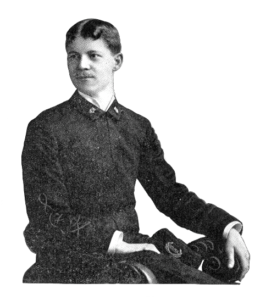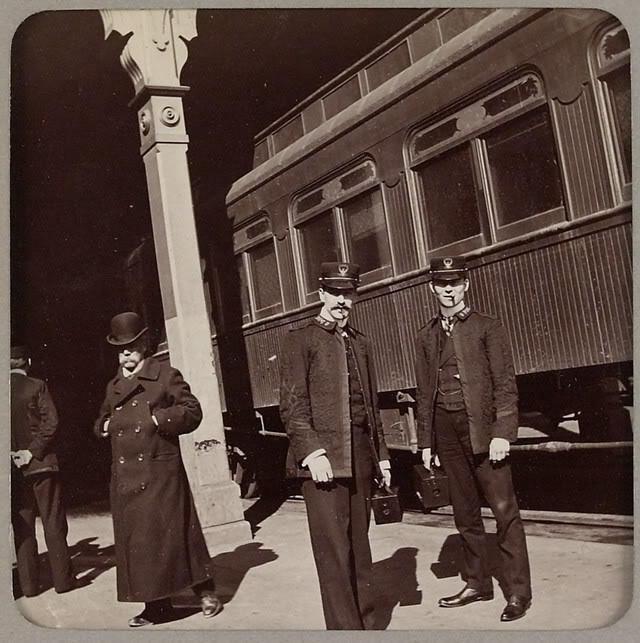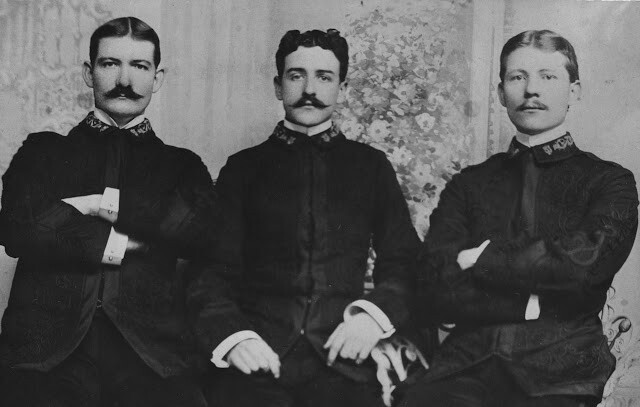In 1893, twenty two year old Arthur Pryor performed his first trombone solo with Sousa’s Band. The time and place couldn’t have been better. The sights and sounds of the Columbian Exposition in Chicago surrounded. For many country folk, this was their first time hearing Sousa’s famous band, now featuring the young Arthur Pryor. The Exposition has been confirmed to be the location where rags were first played to the masses. Overtly syncopated music was on exhibit, and it was with the help of native Missourian Arthur Pryor.
Arthur Pryor is known mostly for his extraordinary ability on the trombone, and his legacy lives on through new students of the instrument studying his arrangements in basic training books. Aside from his phenomenal accomplishments as a trombonist and bandleader, he had a unique mindset when it came to ragtime. Pryor was born in St. Joseph, Missouri, an absolutely choice location and region for the birth of authentic classic ragtime. Pryor as a young boy took to many instruments other than the trombone, including the string bass and piano. It was his skill on the piano that proved most overlooked.
 From the start of his time with the Sousa band, he began writing music, though the popularity of his pieces was hit and miss. Through the mid 1890s, Pryor toured with the Sousa band, playing solos and his own compositions. In 1895, he wrote a very tantalizing number that could be considered a definitive example of early ragtime.
From the start of his time with the Sousa band, he began writing music, though the popularity of his pieces was hit and miss. Through the mid 1890s, Pryor toured with the Sousa band, playing solos and his own compositions. In 1895, he wrote a very tantalizing number that could be considered a definitive example of early ragtime.
While on tour, he composed “A Kansas Two-step.” This piece sported a very crude cover with a pair of black footprints on it, nothing particularly special, but what was inside proved very progressive, yet old-fashioned all at once. In this piece, there is a fair amount of syncopation that would be most reminiscent of a piece from 1898 or 1899, not 1895. Already Pryor had been developing a very distinct composition style, though arriving before the official rag craze began, the piece didn’t receive much recognition.
Pryor’s composition style became even more daring and complicated, he wasn’t afraid to take risks. Many cake-walks of the mid and late-1890’s are a mixed bag when it comes to detailed composition. Some are well put together, others are rather dull. Pryor made sure to make his pieces sound as authentic to his regional style, and his own style as possible. He wrote out eccentric syncopation, rare to see written down, but often played on cylinder recordings of the brown wax era.
By 1899, his ragtime style had reached its zenith, and this is where it remained for many years following. A pair of outstanding rags he wrote in 1899, those being “An Arkansaw Husking Bee” and “Southern Hospitality,” are among the most detailed and eccentric of his ragtime compositions. “The Arkansaw Husking Bee” is supposed to illustrate the type of country music he would have heard growing up near the Kansas and Arkansas borders—and, how it does.
This piece was recorded many times, and illustrates the reasons for his complicated composition style. A 1902 recording of “Arkansaw Husking Bee” by Gilmore’s band included a substantial amount of trombone accompaniment, and also a section where the second and fourth beats of the measures are clearly emphasized (quite daring for 1902!). His “Southern Hospitality” is another piece in a similar vein, with the same sort of very detailed and eccentric composition style, also attempting to illustrate his roots in the so-called “birthplace of ragtime.” Both of these pieces sold well, and were being recorded as many as five years after their original publication date.

Aside from Pryor’s significant output of ragtime, perhaps the most tantalizing thing he did before starting his own band in 1903-1904 was a record he made in September of 1900. On September 27th of 1900, the Improved Gram-O-Phone company (soon to become the Victor talking machine company) recorded a pair of piano solos. The first piano solo recorded on this date was Frank P. Banta performing “Hello, My Baby” and a few numbers later, Arthur Pryor jumped in to play a piano solo. Pryor played a very obscure composition of his own, it being “A Cork Dance,” which is likely in a similar style to pieces like “The Virginia Skeddadle.” It is likely that only a few hundred copies of this record were ever made.
The slim chances of a copy turning up aside, this record would be an invaluable artifact for many reasons. One of these reasons is it would be the only good example of Pryor’s ability on an instrument other than the trombone. The significance of this record spans the worlds of ragtime and record collectors, and the fact that it even happened and was issued is curious. Clearly the major record company that was later to become Victor found Pryor’s ability as a pianist worthy of being recorded, and released to the public (but not in a significant amount). Even with its unbelievable rarity, we can all hope that someday a copy of this record turns up.
When Pryor started his band in 1903-1904, they were an immediate hit with the record companies, though they recorded exclusively for Victor. The first few years at Victor got Pryor inspired to write more of his authentic and curious ragtime. It was between 1904 and 1912 that Pryor wrote some of his most famous works. He wrote “Razzazza Mazzazza” and “The Whistler and his Dog” in 1905, and these turned out to be his most famous works, even long after his death several decades later. As a testament to Pryor’s popularity, his older pieces of the late-1890’s were still being re-recorded in 1905 and later, such as “A Coon Band Contest.”
He and his famous band were still popular into the 1910s, though with so many different exceptional bands and orchestras to choose from in the record market at that time, Pryor’s immediate popularity faded slightly around 1913. With new dances like the one-step and fox-trot making their way into the vernacular, hot detailed folk rags like Pryor’s were falling out of fashion. But this was no deterrent for Pryor.

In 1914 and 15, Pryor took some of his older arrangements, his “Frozen Bill Rag” particularly, and re-wrote them in the more modern fox-trot format. His record of “Frozen Bill Fox-trot” proved a good way to bring the younger generation to appreciate Pryor’s aging classic ragtime mindset. This is why it was no small thing when in 1917 Earl Fuller took on Pryor’s “A Coon Band Contest” as one of his specialties. Fuller’s take on this classic piece of ragtime brought back recognition of Pryor’s compositions of nearly twenty years prior.
So why should we as scholars of ragtime and early jazz take especial note of Pryor’s compositions? Well, consider the context. Pryor grew up around the origins of when became ragtime, being from the northwestern corner of Missouri, Pryor had a valuable musical mindset from the start. He also got the chance to tour around the mid-west and south when it was said that early authentic ragtime and blues were just starting to be played.
Furthermore, if you listen to his pieces in great detail, there lies a very well documented pot-luck of the rhythms and melodies he heard all over his home region and those surrounding, starting from around the late-1870’s. His pieces were drawn out with especial care, like those of classic rag composers Arthur Marshall or James Scott, and all three of them were from the same region.
A further thing to note, Pryor was documenting these eccentric rhythms at the same time that Ben Harney was doing so, taking down some if not all of it quite early (before 1897). So, if you haven’t already, take a listen to his rags and popular pieces. Back then as it does now, his name attached to a piece of music does not disappoint!
R. S. Baker has appeared at several Ragtime festivals as a pianist and lecturer. Her particular interest lies in the brown wax cylinder era of the recording industry, and in the study of the earliest studio pianists, such as Fred Hylands, Frank P. Banta, and Frederick W. Hager.






















